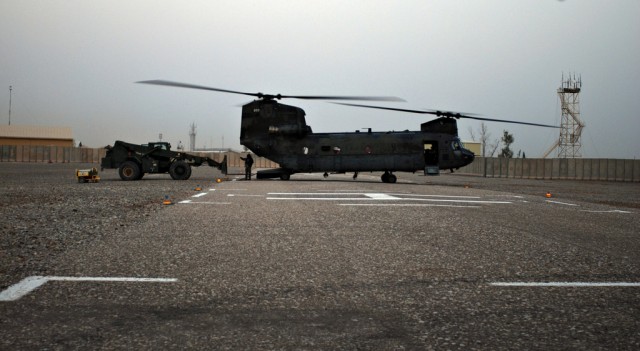BAGHDAD (Army News Service, Aug. 25, 2010) -- While combat troops are leaving Iraq, the helicopters they traveled in while there are sticking around.
The Army's aviation branch is still working at full speed in Iraq, moving personnel to points from which they can return to the States, and preparing the Iraqi army to assume responsibility for their country's skies. As the Iraqis take the lead, U.S. aviators are conducting what commanders call stability operations.
"Past deployments have focused on combat and support operations -- we are seeing a transition to Iraqi Security Forces leading on every level and the U.S. forces taking a support and advisory role," said Lt. Col. Christopher C. Prather, commander of the 2nd General Support Aviation Battalion, 1st Aviation Regiment and Black Hawk pilot.
Command Sgt. Maj. Jake Werner, the battalion's senior noncommissioned officer, added that the beginning of stability operations does not necessarily mean the end of offensive operations in Iraq. Army aviation is still involved in training the Iraqi army in air to ground integration, the synchronization of air and ground assets.
But in the fifth month of his battalion's deployment, the need for offensive operations in minimal.
Noticeably absent from the battalion's roll-up of activity is a tally of air assaults, the frequency of which has tapered off since the end of the troop surge.
Instead, the Chinooks that were once charged with dropping troops into the fight are now used to get them away from it. The battalion has moved 45,000 passengers, two million pounds of cargo, and flown 880 missions totaling nearly ten thousand flight hours.
"Our (Chinooks) have been the primary rotary-wing assets used in the responsible drawdown of forces," said Werner. "The heavy lift mission will continue to be in high demand after the troops levels decrease below 50,000 in Operation New Dawn."
The battalion has seen a reduced number of medical evacuations of wounded troops, said Prather. The battalion has flown 632 medevac missions and evacuated 725 patients.
The battalion belongs to the Combat Aviation Brigade, 1st Infantry Division, from Fort Riley, Kans. The brigade recently became an enhanced combat aviation brigade, a unique unit boasting double the amount of troops and aircraft of a typical aviation unit.
With more brigades leaving for Afghanistan, the CAB, 1st Inf. Div. is taking on sole responsibility for Army aviation operations in Iraq. The brigade currently supports U.S. Divisions North and Center, and is scheduled to become the only Army aviation asset in Iraq this September.
In addition to focusing on the drawdown of forces, the brigade is involved in training Iraqi aviators to assume responsibility for their operations.
"We partner with three Iraqi squadrons: two flight squadrons and an air traffic services squadron," said Werner. "We work closely with them to conduct partnered operations, planning, and cultural exchanges."
Iraqi aviation is at a road mark in its history. Following the U.S. military's example, Iraqi aviation recently switched from the Iraqi air force to the Iraqi army.
"As the Iraqi air force completes the transition into the Iraqi Army Directorate of Aviation, we can offer lessons learned as a branch," said Werner. "U.S. Army aviation carved out a niche as our branch, as well, and has come a long way since 1984. We are happy to share what we have learned, and pass on those successful organizational traits that we developed as a branch."
The battalion recently started flying joint missions with Iraqi aviators to meet this end.
Iraqi aviation is already active in Iraq, but seldom gets involved with U.S. troops -- Iraqis fly Iraqis, Americans fly Americans. This is changing, however, with continued partnership events between the two organizations.
The CAB, 1st Inf. Div., including Prather's battalion, is scheduled to leave Iraq next spring.
"Another (battalion) has been identified to continue the mission after our deployment is complete," said Werner. "The U.S. government is committed to the government of Iraq, and will support the efforts of a safe and secure Iraq."
(Spc. Roland Hale writes for PAO CAB, 1st Inf. Div.)


Social Sharing